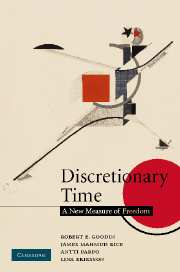Book contents
- Frontmatter
- Contents
- List of figures
- List of tables
- Preface
- Part I Introduction
- Part II Time pressure
- Part III Welfare regimes matter
- Part IV Gender regimes matter
- 10 How gender regimes differ
- 11 A temporal perspective on gender regimes
- 12 Gender regimes and temporal autonomy
- Part V Household regimes matter
- Part IV Conclusions
- Appendix 1 Methodology
- Appendix 2 Data
- Bibliography
- Index
10 - How gender regimes differ
Published online by Cambridge University Press: 28 October 2009
- Frontmatter
- Contents
- List of figures
- List of tables
- Preface
- Part I Introduction
- Part II Time pressure
- Part III Welfare regimes matter
- Part IV Gender regimes matter
- 10 How gender regimes differ
- 11 A temporal perspective on gender regimes
- 12 Gender regimes and temporal autonomy
- Part V Household regimes matter
- Part IV Conclusions
- Appendix 1 Methodology
- Appendix 2 Data
- Bibliography
- Index
Summary
Among feminists themselves it has long been axiomatic that what social-welfare arrangements best promote the interests of women is a question that admits of no single, simple answer. The interests of women are many and varied. Given that heterogeneity, there is no one outcome that is ‘good for all women’.
All theorists of the welfare state surely know that, if they only stopped to think about it. In attempting to ‘gender’ their analyses of welfare states, however, they often proceed in ways that elide it. Among the Scandinavian voices that often dominate these discussions, it is typically taken for granted that what it is for a regime to be ‘woman-friendly’ is to promote female labour-force participation. Ironically, almost the opposite was taken for granted in US debates surrounding the 1996 welfare reforms: it was seen as distinctly ‘woman-unfriendly’ to push poor single mothers into paid labour by withdrawing public assistance.
Women's interests vary in part because their social circumstances vary. Women's interests vary, too, in part because their preferences vary. Catherine Hakim, as we have already seen, makes much of the heterogeneity in women's preferences over issues of ‘work–life balance’. On her (much contested) count, perhaps a fifth of mothers are firmly home-centred and prefer to make a career of marriage and child-raising, with only a fifth being resolutely work-centred (the large remainder being prepared to go either way depending on opportunities and incentives).
- Type
- Chapter
- Information
- Discretionary TimeA New Measure of Freedom, pp. 153 - 176Publisher: Cambridge University PressPrint publication year: 2008

